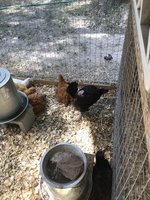She claims the damage is from an aggressive rooster, but I am leaning more towards something else.
Any ideas?
We’ve had them one week-one day in we cleaned them up with Vetericyn, inspected their feet and legs for mites (none), inspected their bellies and booties and necks for lice and mites (can’t find any), treated their lacerations and bald spots with Hen Healer and then sprayed them with Blu-Kote. We’ve been feeding them cat food along with their layer crumbles, lots of dried mealworms and black oil sunflower seeds, and treating their water with Durastat. Today is the first day they have been let out to mingle with our flock.
We’ve been getting GIANT eggs from them-but not all.
They are NOT easily handled-which makes me think they had little attention at their last home.
Eyes look good. Feet are huge, clean. Some of the feathers are broken, some are missing completely.
The lady claims they are Australorps-but we can’t tell at this time.
Any ideas?
Attachments
-
 D6294F16-1D0E-4FE9-9262-4E918C9A90A4.jpeg633.9 KB · Views: 17
D6294F16-1D0E-4FE9-9262-4E918C9A90A4.jpeg633.9 KB · Views: 17 -
 76FD231C-0586-4E3D-A6AB-5D5C2FD73EA2.jpeg1.1 MB · Views: 24
76FD231C-0586-4E3D-A6AB-5D5C2FD73EA2.jpeg1.1 MB · Views: 24 -
 AEA424AB-9659-4A4C-B078-05F158FF7AC9.jpeg1.1 MB · Views: 17
AEA424AB-9659-4A4C-B078-05F158FF7AC9.jpeg1.1 MB · Views: 17 -
 C72C1BCB-5EF6-4F61-A5AC-B422AB9925D2.jpeg941.4 KB · Views: 22
C72C1BCB-5EF6-4F61-A5AC-B422AB9925D2.jpeg941.4 KB · Views: 22 -
 80B7820B-F12D-4C25-86C4-DCBDF3B801E0.jpeg914.8 KB · Views: 20
80B7820B-F12D-4C25-86C4-DCBDF3B801E0.jpeg914.8 KB · Views: 20 -
 FC3BD68B-79E7-422E-9C5F-EEBE349948D9.jpeg881.2 KB · Views: 17
FC3BD68B-79E7-422E-9C5F-EEBE349948D9.jpeg881.2 KB · Views: 17 -
 F19DFF9C-031B-42CD-A260-689F5FC7F3D9.jpeg800.4 KB · Views: 18
F19DFF9C-031B-42CD-A260-689F5FC7F3D9.jpeg800.4 KB · Views: 18 -
 30BB1BF8-9E23-4D39-A5FD-83675EFA8EFA.jpeg690.2 KB · Views: 20
30BB1BF8-9E23-4D39-A5FD-83675EFA8EFA.jpeg690.2 KB · Views: 20 -
 BAB43CC9-2A3C-479E-BF0B-341BC73B3675.jpeg879.4 KB · Views: 15
BAB43CC9-2A3C-479E-BF0B-341BC73B3675.jpeg879.4 KB · Views: 15 -
 8DA4849B-3191-4BFA-B0B1-F32BF3177D97.jpeg836.6 KB · Views: 17
8DA4849B-3191-4BFA-B0B1-F32BF3177D97.jpeg836.6 KB · Views: 17 -
 DF35D180-9289-41AD-BDD9-9E7CCE6002AB.jpeg773.8 KB · Views: 18
DF35D180-9289-41AD-BDD9-9E7CCE6002AB.jpeg773.8 KB · Views: 18 -
 C428D5FB-177B-44DB-A535-2FF2C0617BED.jpeg414.7 KB · Views: 18
C428D5FB-177B-44DB-A535-2FF2C0617BED.jpeg414.7 KB · Views: 18
Last edited:



